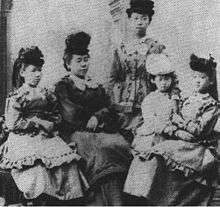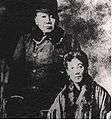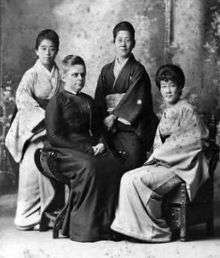Ōyama Sutematsu
| Princess Ōyama Sutematsu | |
|---|---|
| 大山 捨松 | |
 Ōyama Sutematsu | |
| Personal details | |
| Born |
Yamakawa Saki March 16, 1860 |
| Died |
February 18, 1919 (aged 58) Tokyo, Japan |
| Cause of death | pneumonia, by influenza |
| Nationality | Japanese |
| Spouse(s) | |
| Children |
|
| Mother | Saigō Tōi |
| Father | Yamakawa Shigekata |
| Relatives |
Yamakawa Misao (sister) Yamakawa Futaba (sister) Yamakawa Kenjirō (brother) Yamakawa Hiroshi (brother) |
| Alma mater | Vassar College |
| Known for | first Japanese woman to receive an American college degree |
| Other names |
Yamakawa Sakiko Yamakawa Sutematsu |
| Nickname | Stematz |
Princess Ōyama Sutematsu (大山 捨松, born Yamakawa Saki (山川 さき),[1] later Yamakawa Sakiko (山川 咲子) and Yamakawa Sutematsu (山川 捨松); March 16, 1860 – February 18, 1919) was a Japanese woman of the Meiji era, who was a prominent social figure.
Biography
She was born Yamakawa Saki (山川 さき) in March 16, 1860 as the youngest daughter to a family of senior retainer Yamakawa Shigekata (山川 重固) and his wife Saigō Tōi (西郷 艶) (えん) of another karō family, the Saigō, in Aizu. Sakiko's sisters Yamakawa Misao and Yamakawa Futaba, and brothers, Yamakawa Kenjirō and Yamakawa Hiroshi, were famous in their own right, during the Meiji era.
In December 1871, also around that time she was renamed to Yamakawa Sutematsu (山川 捨松), she was sent to the United States for study, as part of the Iwakura Mission. She was placed in the household of Leonard Bacon where she befriended his daughter Alice. The two lived like sisters for ten years learning each other's cultures. Leonard Bacon died in December 24, 1881 without ever present at her eventual graduation. Sutematsu eventually graduated from Vassar College in October 1882 and returned to Japan.
In 1883, Sutematsu married the Imperial Japanese Army general and (and former Satsuma retainer) Ōyama Iwao, a 42 year old widower and father of three, who had once served as an artilleryman during the bombardment of Sutematsu's hometown of Aizu. After her marriage and a series of promotions for her husband who later became the Minister of War, Sutematsu Yamakawa became Countess Ōyama, and later, Princess Ōyama. They later had two daughters, Ōyama Hisako (later Baroness Ida Hisako) and Ōyama Yuko (miscarried), and two sons, Prince Ōyama Takashi and Prince Ōyama Kashiwa. She took on roles common to government officials' wives, but also met with the Empress to give advice on western style and customs, encouraged upper-class Japanese women to volunteer as nurses.
In 1885, due to her pregnancy which prevented her from travelling with her husband to Europe, she was requested by Itō Hirobumi to assist in setting up the Peeresses' School in Tokyo and later became its trustee. In 1900, she was a co-founder with Alice Bacon and Tsuda Ume's Joshi Eigaku Juku (Girls' School for English Studies) to support the cause of women's education.[2]
During the Russo-Japanese War from 1904 to 1905, she worked as a volunteer nurse for the Japan Red Cross Ladies’ Volunteer Nursing Association and the Ladies’ Patriotic Association.
Death
After Ōyama's death in 10 December 1916, Princess Ōyama died of pneumonia caused by influenza in Tokyo, Japan from the 1918 flu pandemic in February 18, 1919.
Gallery
 First female study-abroad students, from the left, Nagai Shigeko (10), Ueda Teiko (16), Yoshimasu Ryōko (16), Tsuda Ume (9) and Yamakawa Sutematsu (12)
First female study-abroad students, from the left, Nagai Shigeko (10), Ueda Teiko (16), Yoshimasu Ryōko (16), Tsuda Ume (9) and Yamakawa Sutematsu (12) Yamakawa Sutematsu at Vassar.
Yamakawa Sutematsu at Vassar. The Vassar College Class of 1882.
The Vassar College Class of 1882. Yamakawa Sutematsu
Yamakawa Sutematsu Princess Ōyama
Princess Ōyama Ōyama Sutematsu in traditional kimono
Ōyama Sutematsu in traditional kimono Ōyama Sutematsu in evening dress
Ōyama Sutematsu in evening dress Princess Ōyama Sutematsu with daughter Ōyama Hisako in drawing
Princess Ōyama Sutematsu with daughter Ōyama Hisako in drawing Ōyama Sutematsu in later years
Ōyama Sutematsu in later years Ōyama Iwao and Ōyama Sutematsu in their later years
Ōyama Iwao and Ōyama Sutematsu in their later years Friends meet again: Tsuda Umeko, Alice Mabel Bacon, Uryū Shigeko, Ōyama Sutematsu (from left to right)
Friends meet again: Tsuda Umeko, Alice Mabel Bacon, Uryū Shigeko, Ōyama Sutematsu (from left to right)
References
- ↑ Nimura, Janice P. (2015). Daughters of the Samurai: A Journey from East to West and Back. WW Norton & Company. pp. .
The youngest child of the late Shigekata Yamakawa, chief retainer of the lord of Aizu, she was called Sakiko then: "blossom child."
- ↑ "Oyama, Sutematsu Yamakawa (VC 1882) - Archives & Special Collections Library - Vassar College". specialcollections.vassar.edu. Retrieved 2018-06-12.
- Hotta, Eri (2013). Japan 1941. New York: Alfred A. Knopf, pp. 83–85.
- Kuno, Akiko (1993). Unexpected destinations: the poignant story of Japan's first Vassar graduate. New York: Kodansha International.
- Methodist Episcopal Church. "Three Japanese Girls." The Heathen Woman's Friend. Vol. XXVII, July 1895, No. 1, Boston: Woman's Foreign Missionary Society of the Methodist Episcopal Church, 1895.
External links
| Wikimedia Commons has media related to Category:Ōyama Sutematsu. |
- Oyama Sutematsu at specialcollections.vassar.edu